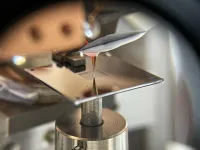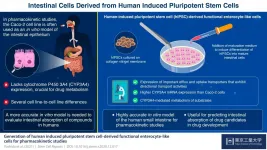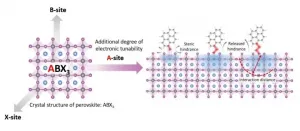New microscopy concept enters into force
The first demonstration of an approach that inverts the standard paradigm of scanning probe microscopy raises the prospect of force sensing at the fundamental limit.
2021-02-05
(Press-News.org) The development of scanning probe microscopes in the early 1980s brought a breakthrough in imaging, throwing open a window into the world at the nanoscale. The key idea is to scan an extremely sharp tip over a substrate and to record at each location the strength of the interaction between tip and surface. In scanning force microscopy, this interaction is -- as the name implies -- the force between tip and structures on the surface. This force is typically determined by measuring how the dynamics of a vibrating tip changes as it scans over objects deposited on a substrate. A common analogy is tapping a finger across a table and sensing objects placed on the surface. A team led by Alexander Eichler, Senior Scientist in the group of Prof. Christian Degen at the Departement of Physics of ETH Zurich, turned this paradigm upside down. Writing in Physical Review Applied, they report the first scanning force microscope in which the tip is at rest while the substrate with the samples on it vibrates.
Tail wagging the dog
Doing force microscopy by 'vibrating the table under the finger' may look like making the entire procedure a whole lot more complicated. In a sense it does. But mastering the complexity of this inverted approach comes with great payoff. The new method promises to push the sensitivity of force microscopy to its fundamental limit, beyond what can be expected from further improvements of the conventional 'finger tapping' approach.
The key to the superior sensitivity is the choice of substrate. The 'table' in the experiments of Eichler, Degen and their co- workers is a perforated membrane made of silicon nitride, a mere 41 nm in thickness. Collaborators of the ETH physicists, the group of Albert Schliesser at the University of Copenhagen in Denmark, have established these low- mass membranes as outstanding nanomechanical resonators with extreme 'quality factors'. That is, that once the membrane is tipped on, it vibrates millions of times, or more, before coming to rest. Given these exquisite mechanical properties, it becomes advantageous to vibrate the 'table' rather than the 'finger'. At least in principle.
New concept put to practice
Translating this theoretical promise into experimental capability is the objective of an ongoing project between the groups of Degen and Schliesser, with theory support from Dr. Ramasubramanian Chitra and Prof. Oded Zilberberg of the Institute for Theoretical Physics at ETH Zurich. As a milestone on that journey, the experimental teams have now demonstrated that the concept of membrane- based scanning force microscopy works in a real device.
In particular, they showed that neither loading the membrane with samples nor bringing the tip to within a distance of a few nanometres compromises the exceptional mechanical properties of the membrane. However, once the tip approaches the sample even closer, the frequency or amplitude of the membrane changes. To be able to measure these changes, the membrane features not only an island where tip and sample interact, but also a second one -- mechanically coupled to the first -- from where a laser beam can be partially reflected, to provide a sensitive optical interferometer.
Quantum is the limit
Putting this setup to work, the team successfully resolved gold nanoparticles and tobacco mosaic viruses. These images serve as a proof of principle for the novel microscopy concept, but they do not yet push the capabilities into new territory. But the destination is just there. The researchers plan to combine their novel approach with a technique known as magnetic resonance force microscopy (MRFM), to enable magnetic resonance imaging (MRI) with a resolution of single atoms, thus providing unique insight, for example, into viruses.
Atomic-scale MRI would be another breakthrough in imaging, combining ultimate spatial resolution with highly specific physical and chemical information about the atoms imaged. For the realization of that vision, a sensitivity close to the fundamental limit given by quantum mechanics is needed. The team is confident that they can realise such a 'quantum-limited' force sensor, through further advances in both membrane engineering and measurement methodology. With the demonstration that membrane-based scanning force microscopy is possible, the ambitious goal has now come one big step closer.
INFORMATION:
[Attachments] See images for this press release:

ELSE PRESS RELEASES FROM THIS DATE:
2021-02-05
A new study by Indiana University found women, younger individuals, those with lower levels of formal education, and people of color are being hit hardest by the COVID-19 pandemic.
The study, published in the Proceedings of the National Academy of Sciences journal, found that Black adults were three times as likely as whites to report food insecurity, being laid off, or being unemployed during the pandemic. Additionally, residents without a college degree were twice as likely to report food insecurity (compared to those with some college) while those not completing high school are four times as likely to report it, compared ...
2021-02-05
Cases of symptomatic COVID-19 were extremely low among children and staff at a network of YMCA summer camps held last year in North Carolina that took precautions like masking and physical distancing, with close to zero transmissions occurring at the camps, according to researchers at Duke Health, Weill Cornell Medicine and NewYork-Presbyterian.
In the camps' 2020 sessions, there were 19 cases of COVID-19 among 5,344 staff and 1,486 youth, only two of which were linked to possible on-site transmission at a group of YMCA of the Triangle camps, at a time ...
2021-02-05
The modern world is powered by electrical circuitry on a "chip"--the semiconductor chip underpinning computers, cell phones, the internet, and other applications. In the year 2025, humans are expected to be creating 175 zettabytes (175trillion gigabytes) of new data. How can we ensure the security of sensitive data at such a high volume? And how can we address grand-challenge-like problems, from privacy and security to climate change, leveraging this data, especially given the limited capability of current computers?
A promising alternative is emerging quantum communication and computation technologies. For this to happen, however, it will require the widespread ...
2021-02-05
Enterocytes, which line the epithelium of the small intestine, are the sites of absorption and metabolism of most orally consumed medications. For this reason, studies on the absorption of novel oral drugs rely on in vitro or animal models to accurately recreate the environment of the small intestine. Currently, scientists widely use the human colon cancer cell line Caco-2 as a model of the intestinal epithelium. However, this has its drawbacks: Caco-2 cells have been derived from the colon; therefore, they more closely resemble the colon than the small intestine. For example, these cells do not express cytochrome P450 3A4 (CYP3A4), a protein critical for drug metabolism that is abundantly expressed in the small intestine. Moreover, Caco-2 ...
2021-02-05
Fresno, CA - A recent human study published in the Journal of the American Academy of Dermatology found that consuming grapes protected against ultraviolet (UV) skin damage.1 Study subjects showed increased resistance to sunburn and a reduction in markers of UV damage at the cellular level. 2 Natural components found in grapes known as polyphenols are thought to be responsible for these beneficial effects.
The study, conducted at the University of Alabama, Birmingham and led by principal investigator Craig Elmets, M.D., investigated the impact of consuming whole grape powder - equivalent to 2.25 cups of grapes ...
2021-02-05
DALLAS - Feb. 5, 2021 - The COVID-19 pandemic is having a detrimental impact on substance use, mental health, and weight-related health behaviors among people with obesity, according to a new study by researchers at UT Southwestern and the END ...
2021-02-05
Health care and education systems are two main pillars of a community's stability. How well and how quickly a community recovers following a natural disaster depends on the resilience of these essential social services.
New research from the Colorado State University Department of Civil and Environmental Engineering, published in Nature Scientific Reports, has found hospitals and schools are interdependent, suggesting their collective recovery must be considered in order to restore a community in the wake of disaster.
Because hospitals and schools are so integral to a community's well-being, Associate Professor Hussam Mahmoud and Ph.D. graduate student Emad Hassan wanted to determine the correlation between them to understand their overall influence on community ...
2021-02-05
UCLA materials scientists and colleagues have discovered that perovskites, a class of promising materials that could be used for low-cost, high-performance solar cells and LEDs, have a previously unutilized molecular component that can further tune the electronic property of perovskites.
Named after Russian mineralogist Lev Perovski, perovskite materials have a crystal-lattice structure of inorganic molecules like that of ceramics, along with organic molecules that are interlaced throughout. Up to now, these organic molecules appeared to only serve a structural function and could not directly contribute to perovskites' electronic performance.
Led by UCLA, a new study shows that when the organic molecules ...
2021-02-05
Gene expression is a highly regulated process, which involves several steps. These include transcription of DNA instructions into RNA, removal of non-coding segments from the RNA message, and its subsequent translation into proteins. All these steps involve specific molecular machineries responsible for conducting each process with high accuracy. The Galej group, based at EMBL Grenoble, studies the structure and function of the RNA-protein complexes that are involved in the regulation of gene expression.
During transcription, genetic information contained in the DNA is used to create a precursor messenger RNA (pre-mRNA) thanks to the action of an enzyme, RNA Polymerase II. To maintain only the necessary coding segments ...
2021-02-05
All life on earth evolved multiple layers and networks of ensuring survival upon catastrophic events. Even cells have their emergency plan: the heat shock response. Triggered by multiple stress stimuli such as heat, toxins, or radiation, this cellular safety program tries to prevent permanent damage to the organism. The response resembles an overall adopted "lockdown" strategy witnessed during the global corona virus pandemic. During a lockdown, only essential activities are permitted and resources were diverted towards measures ensuring minimizing the impact of a pandemic.
Under normal conditions, RNA polymerase II rushes down the DNA. At the correct places, the DNA is transcribed into mRNA, which is then translated into proteins. In a crisis, ...
LAST 30 PRESS RELEASES:
[Press-News.org] New microscopy concept enters into force
The first demonstration of an approach that inverts the standard paradigm of scanning probe microscopy raises the prospect of force sensing at the fundamental limit.





